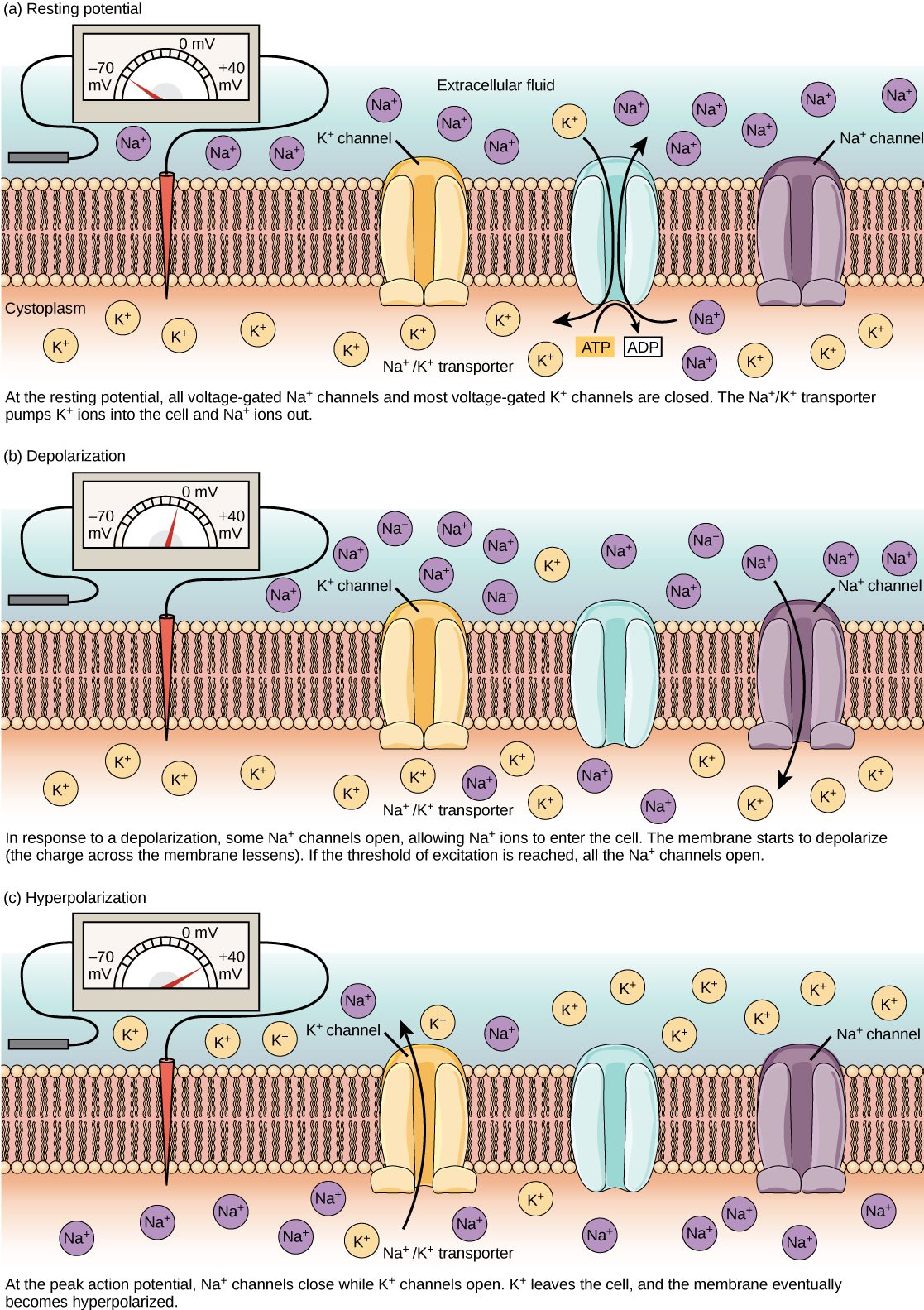Playlist
Show Playlist
Hide Playlist
Postsynaptic Potential (PSP) and Binding
-
Slides 01 NervesNeurotransmission NervousSystem.pdf
-
Download Lecture Overview
00:00 So now let’s talk about once we have this post-synaptic response. 00:07 How do you propagate an action potential? Probably, the best way to think about here, is that you need to depolarize that postsynaptic membrane. 00:19 So what I mean by depolarize? Remember from membrane potential, a depolarization is moving up or becoming less negative. 00:29 A hyperpolarization is moving down. 00:33 So with our depolarization component, we have two things that could happen. 00:39 Either when we bind to our postsynaptic membrane, we have a subthreshold event or we have a threshold event. 00:49 If you are able to eclipse threshold, you will get an action potential. 00:55 If you are subthreshold even though you stimulated that postsynaptic membrane you actually will not obtain an action potential. 01:05 So this threshold is a very important concept to have in mind. 01:10 Each individual nerve will have a threshold limit. 01:14 And you need to get enough signal up to that point to reach threshold. 01:19 And again, once that’s reached, you will then propagate that action potential. 01:24 So let’s go through some processes here that will make this more understandable and how we quantify things like subthreshold depolarization or hyperpolarization. 01:35 This is done by looking at excitatory post-synaptic potentials. 01:41 We often times abbreviate these EPSPs for short. 01:46 So there’s ways that we can maximize the amount of potential that comes across the membrane. 01:55 If you have one stimulation, you usually get one depolarization. 02:00 So maybe, away to get greater amount to depolarization is use more than one nerve. 02:06 If you do that, you get a bigger response. 02:09 Finally, if you bombarded with a number of different axons, bam, you will get a higher response. 02:16 And usually, when you get that higher response you can then trigger a threshold event. 02:22 Another way to do this besides using multiple axon terminals that will bought up against a particular neuron is to have them occur very frequently. 02:33 So you could have one particular axon terminal giving multiple signals. 02:37 Really vast. 02:38 And with that will allow to have happen is to build up membrane potential to again hopefully, do what? Reach threshold. 02:48 Cause, if we can reach threshold, we will be able to develop an action potential. 02:54 I would like to say that all subthreshold events are positive. 02:59 Cause you know like we like to stay positive, don’t we? We don’t like to get too negative on things. 03:04 But that’s unfortunately we have to add both the positives and negatives in real life. 03:09 And that’s we have to do here for excitatory postsynaptic potentials and the opposite which is inhibitory post synaptic potential. 03:18 So we look at the positives first. 03:20 Let’s take a membrane potential that starts out at -70 millivolt. 03:25 You can see here two green blips. 03:29 Those are EPSPs, a signal from another nerve telling this particular nerve to fire. 03:37 At point A, we have not yet reach threshold. 03:41 In our example here, threshold is -55. 03:45 So no action potentials has occurred yet. 03:48 It will be nice if we got one more of these EPSPs to let us have reach threshold, right? Unfortunately, an IPSP just came in, not our threshold down, not our threshold but there membrane potential down cause it hyperpolarized that particular response. 04:09 Then we are at baseline for a little bit. 04:11 We give another EPSP, its gets depolarized further. We’re getting close to threshold. 04:17 Another IPSP just came in and hyperpolarize the membrane. 04:21 Luckily, the EPSPs didn’t give up. They got another couple of hits. 04:28 and that way will move membrane potential up to eventually reaching threshold and right it be, we got an action potential. 04:36 And that is what’s going on constantly in the brain and throughout many nerves in the body. 04:42 You’re getting all of these signals. 04:45 Sometimes, a signal will cause an event like an action potential. 04:49 And sometimes they just buildup. 04:51 But you have to remember you to need to sum up the total of EPSPs and IPSPs to see if you can reach threshold.
About the Lecture
The lecture Postsynaptic Potential (PSP) and Binding by Thad Wilson, PhD is from the course Neurophysiology.
Included Quiz Questions
Which of the following statements regarding action potential is TRUE?
- A threshold event generates an action potential.
- The depolarized synaptic membrane is more negative than the hyperpolarized membrane.
- Reaching the subthreshold level is enough to generate an action potential.
- Reaching the subthreshold level stimulates the postsynaptic membrane.
- Multiple depolarizing events minimizes the chance of action potential generation.
What happens when an IPSP is generated after EPSP?
- Membrane is hyperpolarized
- Action potential is reached
- Effect of subthreshold is enhanced
- Membrane is more depolarized
- A threshold event takes place
Which of the following would NOT be possible occurrences when signal build-up occurs?
- They can reach action potential as a result of IPSP.
- They can reach action potential as a result of EPSP.
- An action potential will reach if a number of EPSP > IPSP.
- IPSP can hyperpolarize the membrane.
Customer reviews
5,0 of 5 stars
| 5 Stars |
|
1 |
| 4 Stars |
|
0 |
| 3 Stars |
|
0 |
| 2 Stars |
|
0 |
| 1 Star |
|
0 |
the way how the professor explain the topic is very easy to learn




